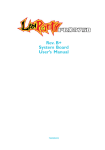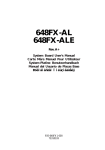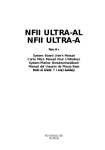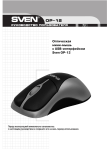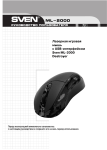Download DFI LanParty PRO875B User`s manual
Transcript
Rev. A+ System Board User’s Manual Carte Mère Manuel Pour Utilisateur System-Platine Benutzerhandbuch Manual del Usuario de Placas Base Ðóêîâîäñòâî Ïîëüçîâàòåëÿ 935-875001-000 74800331 Copyright This publication contains information that is protected by copyright. No part of it may be reproduced in any form or by any means or used to make any transformation/adaptation without the prior written permission from the copyright holders. This publication is provided for informational purposes only. The manufacturer makes no representations or warranties with respect to the contents or use of this manual and specifically disclaims any express or implied warranties of merchantability or fitness for any particular purpose. The user will assume the entire risk of the use or the results of the use of this document. Further, the manufacturer reserves the right to revise this publication and make changes to its contents at any time, without obligation to notify any person or entity of such revisions or changes. © 2003. All Rights Reserved. Trademarks Windows® 98 SE, Windows® ME, Windows® 2000, Windows NT® 4.0 and Windows® XP are registered trademarks of Microsoft Corporation. Intel® and Pentium® 4 are registered trademarks of Intel Corporation. Award is a registered trademark of Award Software, Inc. Other trademarks and registered trademarks of products appearing in this manual are the properties of their respective holders. Caution To avoid damage to the system: • Use the correct AC input voltage range.. To reduce the risk of electric shock: • Unplug the power cord before removing the system chassis cover for installation or servicing. After installation or servicing, cover the system chassis before plugging the power cord. Battery: • Danger of explosion if battery incorrectly replaced. • Replace only with the same or equivalent type recommend by the manufacturer. • Dispose of used batteries according to the batter y manufacturer’s instructions. Joystick or MIDI port: • Do not use any joystick or MIDI device that requires more than 10A current at 5V DC. There is a risk of fire for devices that exceed this limit. FCC and DOC Statement on Class B This equipment has been tested and found to comply with the limits for a Class B digital device, pursuant to Part 15 of the FCC rules. These limits are designed to provide reasonable protection against harmful interference when the equipment is operated in a residential installation. This equipment generates, uses and can radiate radio frequency energy and, if not installed and used in accordance with the instruction manual, may cause harmful interference to radio communications. However, there is no guarantee that interference will not occur in a particular installation. If this equipment does cause harmful interference to radio or television reception, which can be determined by turning the equipment off and on, the user is encouraged to try to correct the interference by one or more of the following measures: • Reorient or relocate the receiving antenna. • Increase the separation between the equipment and the receiver. • Connect the equipment into an outlet on a circuit different from that to which the receiver is connected. • Consult the dealer or an experienced radio TV technician for help. Notice: 1. The changes or modifications not expressly approved by the party responsible for compliance could void the user's authority to operate the equipment. 2. Shielded interface cables must be used in order to comply with the emission limits. Quick Setup Guide 1 Quick Setup Guide Important Configuration and Driver Installation Rules HighPoint RAID IDE Controller By default, the HighPoint RAID IDE controller is enabled. If you are not using this function, make sure to set the “RAID Device Control” field in the Genie BIOS Setting submenu of the Award BIOS to Disabled. Make sure to follow the rule mentioned above. Doing it otherwise will slow down the boot up time and affect the performance of the system. Driver Installation Rules Please follow the installation sequence below. 1. Install the “Audio Drivers”. 2. Install the “Intel Chipset Software Installation Utility”. 3. Install the other drivers and utilities. Make sure to follow this sequence. Doing it otherwise will slow down the boot up time and affect the performance of the system. The user’s manual in the provided CD contains detailed information about the system board. If, in some cases, some information doesn’t match those shown in this manual, this manual should always be regarded as the most updated version. Le manuel d’utilisateur dans le CD muni contient renseignement détaillé au sujet de carte de système. Si, en quelque cas, quelque renseignement n’appareille de ce que dit dans ce manuel, ce manuel doit toujours être considéré comme la plus nouvelle version. Das Benutzerhandbuch in der angebotenen CD enthält detaillierte Informationen über die Hauptplatine. Wenn in manchen Fällen manche Informationen nicht denjenigen Informationen dargestellt in diesem Handbuch entsprechen, soll dieses Handbuch als die meist aktualisierte Ausgabe gelten. El uso explicativo contene información detalle sobre la sistema board en el CD preparativo. Si en algún caso, la información no es igual con el uso explicativo, necesita ver el uso explicativo, esque es más nuevo.  ðóêîâîäñòâå ïîëüçîâàòåëÿ íà ïðåäîñòàâëÿåìîì CD äèñêå ñîäåðæèòñÿ ïîäðîáíàÿ èíôîðìàöèÿ î ìàòåðèíñêîé ïëàòå. Èíîãäà íàïå÷àòàííîå ðóêîâîäñòâî ìîæåò íå ñîâïàäàòü ðóêîâîäñòâîì íà CD, òàê êàê ïîñëåäíåå íàèáîëåå ÷àñòî îáíîâëÿåòñÿ è ÿâëÿåòñÿ ñàìûì ñâåæèì. 4 Table of Contents Chapter 1 Quick Setup Guide............................................. 6 1 Quick Setup Guide Quick Setup Guide Chapter 2 English...................................................................... 18 Chapter 3 Français.................................................................... 24 Chapter 4 Deutsch............................................................................... 30 Chapter 5 Español............................................................................ 36 Chapter 6 Ðóññêèé...................................................................... 42 5 Quick Setup Guide 1 6 Quick Setup Guide Chapter 1 - Quick Setup Guide 1.1 System Board Layout Quick Setup Guide Quick Setup Guide 1.2 Jumpers 1.2.1 Clear CMOS Data - JP5 JP5 1 ! 3 3 2 2 1 1-2 On: Normal (default) 1 2-3 On: Clear CMOS Data 1.2.2 Wake-On-Keyboard/Wake-On-Mouse - JP1 JP1 ! 1 1 2 2 3 1-2 On: Disabled (default) 3 2-3 On: Enabled The 5VSB power source of your power supply must support ≥720mA. 7 Quick Setup Guide 1 Quick Setup Guide 1.2.3 Wake-On-USB Keyboard - JP2 and JP6 USB 1-4 (JP2) 3 3 ! 2 2 1 1 1-2 On: Disabled (default) USB 5-8 (JP6) ! 1 2-3 On: Enabled 1 2 3 1-2 On: Disabled (default) 2 3 2-3 On: Enabled If you are using the Wake-On-USB Keyboard function for 2 USB ports, the 5VSB power source of your power supply must support ≥1.5A. If you are using the Wake-On-USB Keyboard function for 3 or more USB ports, the 5VSB power source of your power supply must support ≥2A. 1.3 Rear Panel I/O Ports PS/2 Mouse RJ45 Mic-in LAN Line-in Parallel USB 2 Center/Bass Rear out PS/2 K/B 8 COM S/PDIF-in USB 1 USB 3-4 S/PDIF-out Line-out Quick Setup Guide Quick Setup Guide 1.4 I/O Connectors 1 1.4.1 S/PDIF-in/out Jacks " S/PDIF-in S/PDIF-out RCA Jacks SPDIF out Key GND VCC SPDIF in 5" 1 J4 For optical S/PDIF cable connection. 1.4.2 Universal Serial Bus Ports USB 2 USB 1 " " VCC -Data +Data Ground N. C. VCC -Data +Data Ground N. C. USB 4 USB 3 USB 5-6 USB 7-8 10 9 2 1 VCC -Data +Data Ground Key VCC -Data +Data Ground Key " " 10 9 2 1 9 Quick Setup Guide 1 Quick Setup Guide 1.4.3 Audio Mic-in Line-in Line-out " Center/Bass " GND AuD_Vcc AuD_R_Return Key AuD_L_Return Rear out 2 1 " Front audio Mic Mic Power AuD_R_Out N. C. AuD_L_Out 10 9 1.4.4 Game/MIDI Port 2 " 1 10 15 Quick Setup Guide Ground Ground Left audio Right audio channel channel 1 4 CD-in Quick Setup Guide 1.4.5 Internal Audio Connectors 1 Ground Ground Left audio Right audio channel channel 4" 1 AUX-in 1.4.6 FDD and IDE Disk Drive Connectors 33 34 IDE 1 ! IDE 2 ! 2 ! 2 39 39 40 40 1 IDE 2 2 1 IDE 1 1 FDD 11 Quick Setup Guide 1.4.7 Serial ATA Connectors 1 7 SATA 2 !1 7 SATA 1 GND TXP TXN GND RXN RXP GND Quick Setup Guide 1 The ICH5R south bridge chip allows configuring RAID on serial ATA drives. It supports RAID 0 and 1. 1.4.8 RAID IDE Disk Drive Connectors 2 RAID 2 1 2 40 39 RAID 1 40 ! 1 39 The HighPoint RAID controller allows configuring RAID on hard drives connected to these RAID IDE connectors. It supports RAID 0, 1, 0+1 and 1.5. 12 Quick Setup Guide Quick Setup Guide 1.4.9 IrDA Connector 1 IRRX N. C. Ground VCC IRTX 1 5" 1.4.10 EZ Touch Switches (Power Switch and Reset Switch) Power Switch ! Reset Switch The presence of the power switch and reset switch on the system board are user-friendly especially to DIY users. They provide convenience in powering on and/or resetting the system while fine tuning the system board before it is installed into the system chassis. 13 Quick Setup Guide Quick Setup Guide 1.4.11 Cooling Fan Connectors ! On/Off Power Sense 1 3 Power Ground Sense 1 ! 1 3 CPU fan Chip fan ! Ground Power N. C. 1 3 Chassis fan Power On/Off Sense 3 ! 1 Second fan 1.4.12 Power Connectors 11 1 ! 3.3V 3.3V Ground +5V Ground +5V Ground PW-OK 5VSB +12V 3.3V -12V Ground PS-ON Ground Ground Ground -5V +5V +5V 20 10 +12V Ground 1 !2 3 4 Ground +12V 14 The system board requires a minimum of 250 Watt power supply to operate. Your system configuration (amount of memory, add-in cards, peripherals, etc.) may exceed the minimum power requirement. To ensure that adequate power is provided, use a 300 Watt (or greater) power supply. Quick Setup Guide Quick Setup Guide 1.4.13 Wake-On-LAN Connector 1 Ground WOL +5VSB !1 3 The 5VSB power source of your power supply must support ≥720mA. LEDs D-LED1D-LED2D-LED3D-LED4N. C. DIMM Standby Power LED Diagnostic LED PCI Standby Power LED 10 9 2 !1 D-LED1+ D-LED2+ D-LED3+ D-LED4+ Key 1.4.14 15 Quick Setup Guide 1 Quick Setup Guide LED 1 LED 2 LED 3 LED 4 Early program chipset register before POST. On Off Off Off Testing memory presence. Off On Off Off Detecting memory size. On On Off Off No memory present. Off Off On Off Programming DRAM timing register. On Off On Off Calculating DRAM size variable including row, column and bank. Off On On Off Initializing JEDEC of current DRAM row. On On On Off Checking CMOS checksum and battery. Off Off Off On Initializing the clock generator. On Off Off On Initializing USB. Off On Off On Testing all memor y (cleared all extended memory to 0). On On Off On Off Off On On On Off On On Off On On On On On On On Initializing the onboard Super IO. Detecting and installing an IDE device. Final initialization. Booting the system. 16 Quick Setup Guide Quick Setup Guide 1.4.15 Front Panel Connectors 1 2019 SPEAKER J5 ! ATX-SW RESET HD-LED PWR-LED 21 Pin Pin Assignment HD-LED (Primary/Secondary IDE LED) 3 5 HDD LED Power HDD Reserved 14 16 N. C. N. C. ATX-SW (ATX power switch) 8 10 PWRBT+ PWRBT- Reserved 18 20 N. C. N. C. RESET (Reset switch) 7 9 Ground H/W Reset SPEAKER (Speaker connector) 13 15 17 19 Speaker Data N. C. Ground Speaker Power PWR-LED (Power/Standby LED) 2 4 6 LED Power (+) LED Power (+) LED Power (-) or Standby Signal 17 2 English Chapter 2 - English 2.1 Features and Specifications English Processor • Intel® Pentium® 4 Processor with Hyper-Threading Technology - 800MHz/533MHz system data bus • Intel® Pentium® 4 Northwood processor - 533MHz/400MHz system data bus • Intel® Celeron® Northwood processor - 400MHz system data bus Chipset • Intel® 875P chipset - Intel® 82875P Memory Controller Hub (MCH) - Intel® 82801ER I/O Controller Hub (ICH5R) System Memory • Supports dual channel (128-bit wide) memory interface - Each channel supports 2 DIMM sockets • Supports up to 4GB system memory • Supports Dynamic mode to optimize system performance • Synchronous operation with processor system bus - PC2100/PC2700/PC3200 (DDR266/DDR333/DDR400) with 800MHz FSB CPU (supports PAT mode). DDR333 will run at 320MHz memory frequency when used with 800MHz FSB CPU. - Use PC2100/PC2700 (DDR266/DDR333) with 533MHz FSB CPU - Use PC2100 (DDR266) with 400MHz FSB CPU • Supports ECC/non-ECC DIMMs • Supports unbuffered DIMMs BIOS • Award BIOS, Windows ® 98SE/2000/ME/XP Plug and Play compatible • Genie BIOS provides: - CPU/DRAM overclocking 18 English 2 - AGP/PCI/SATA overclocking - CPU/DIMM/AGP overvoltage • Flash EPROM for easy BIOS upgrades • Supports DMI 2.0 function • 4Mbit flash memory Energy Efficient Design ACPI STR (Suspend to RAM) function Wake-On-PS/2 Keyboard/Mouse Wake-On-USB Keyboard Wake-On-Ring Wake-On-LAN RTC timer to power-on the system AC power failure recovery English • • • • • • • System Health Monitor Functions • Monitors CPU/system temperature and overheat alarm • Monitors CPU/1.5V/5VSB/VBAT/3.3V/5V/±12V voltages and failure alarm • Monitors the fan speed of the CPU fan, chip fan and second fan; and failure alarm • Automatic chip fan and second fan on/off control • Read back capability that displays temperature, voltage and fan speed • CPU Fan Protection function monitors CPU fan during system boot-up • CPU Temperature Protection function monitors CPU temperature during system boot-up Onboard Audio Features • 20-bit stereo full-duplex codec with independent variable sampling rate • High quality differential CD input • True stereo line level outputs • S/PDIF-in/out interface • 6-channel audio output 19 2 English Onboard CSA Gigabit LAN Features • Uses 82547EI Gigabit LAN CSA (Communication Streaming Architecture) interface • Integrated power management functions • Full duplex support at 10, 100 and 1000 Mbps • Supports IEEE 802.3u auto-negotiation • Supports wire for management English ATA RAID - Redundant Array of Independent Disk • Uses HighPoint 372N RAID controller • RAID 0, 1, 0+1 and 1.5 - RAID 1.5 performs data stripping and mirroring simultaneously using two drives only • Two independent IDE channels suppor t up to 4 drives (ATA/33, ATA/66, ATA/100, ATA/133 or EIDE) • Suppor ts PIO modes 0/1/2/3/4, DMA modes 0/1/2 and UDMA modes 0/1/2/3/4/5/6 PCI Bus Master IDE Controller • Supports ATA/33, ATA/66 and ATA/100 hard drives • PIO Mode 4 Enhanced IDE (data transfer rate up to 14MB/ sec.) • Bus mastering reduces CPU utilization during disk transfer • Supports ATAPI CD-ROM, LS-120 and ZIP ICH5R SATA IDE/RAID Interface • Two SATA (Serial ATA) interfaces which are compliant with SATA 1.0 specification (1.5Gbps interface) • Supports RAID 0 and 1 Processor Socket • Socket 478 AGP (Accelerated Graphics Port) • Supports AGP 3.0 (AGP 4x and 8x) and AGP 2.0 (AGP 1x and 4x) spec. • Supports 1.5V AGP 8x (2.13GB/sec.) and AGP 4x (1066MB/ sec.) add-in cards. AGP 2x and 3.3V AGP cards are not supported. 20 English 2 Rear Panel I/O Ports (PC 99 color-coded connectors) 4 USB 2.0/1.1 ports 1 RJ45 LAN port 1 DB-9 serial port 1 DB-25 parallel port 1 mini-DIN-6 PS/2 mouse port 1 mini-DIN-6 PS/2 keyboard port 2 S/PDIF RCA jacks (S/PDIF-in and S/PDIF-out) 3 audio jacks: line-out, line-in and mic-in 2 audio jacks for center/bass and rear out English • • • • • • • • • I/O Connectors • • • • • • • • • • • • • • 2 connectors for 4 additional external USB 2.0/1.1 ports 1 front audio connector for external line-out and mic-in jacks 1 connector for an external game/MIDI port 2 internal audio connectors (CD-in and AUX-in) 1 S/PDIF connector for optical cable connection 1 connector for IrDA interface 2 RAID IDE connectors 2 Serial ATA connectors 2 IDE connectors 1 floppy connector 2 ATX power supply connectors 1 Wake-On-LAN connector CPU fan, chassis fan, second fan and chip fan connectors 1 diagnostic LED connector for 4 external diagnostic LEDs display • EZ touch switches (power switch and reset switch) Expansion Slots • 1 AGP slot • 5 PCI slots Compatibility • PCI 2.2 and AC ’97 compliant • Intel AGP version 3.0 21 2 English 2.2 CMOS Reloaded The CMOS Reloaded feature allows you to save different BIOS configurations and when needed, allows you to conveniently restore one of these previously saved configurations. Select CMOS Reloaded in the main menu of the Award BIOS then press <Enter>. English You can save up to two configurations - in the “User Define Config 1” and “User Define Config 2” fields. Saving a Configuration After you have made the proper settings, move the cursor to “Backup” of “User Define Config 1” then press <Enter>. Restoring a Configuration To restore one of the previously saved configurations, move the cursor to “Load” of “User Define Config 1” then press <Enter>. Renaming a Configuration The default name given in the “User Define Config 1” field is “Config 1” and “Config 2” in the “User Define Config 2” field. To rename, move the cursor to “Rename” then press <Enter>. You can enter up to 16 characters. To save another configuration, repeat the procedures above but this time, in the “User Define Config 2” field. 22 English 2 2.3 Package Checklist The system board package contains the following items: ! ! ! ! ! ! ! ! ! One LANPARTY PRO875B system board One LANPARTY PRO875B user’s manual One LANPARTY Features user’s manual Two IDE round cables One floppy round cable Two serial ATA data cables One serial ATA power cable One card-edge bracket mounted with a game/MIDI port One PC Transpo kit One FrontX device equipped with: - Two USB 2.0/1.1 ports - One line-out jack - One mic-in jack - Four diagnostic LEDs One I/O shield One thermal paste One LANPARTY sticker One case badge One pack of jumper caps (five 2.54mm jumper caps) One “HighPoint 372 N RAID Drivers” diskette One “Intel ICH5R RAID Driver” diskette One “Mainboard Utility” CD One “WinDVD/WinRIP Utility” CD English ! ! ! ! ! ! ! ! ! ! If any of these items are missing or damaged, please contact your dealer or sales representative for assistance. Please refer to the LANPARTY Features manual for more information on the FrontX device. 23 3 Français Chapter 3 - Français 3.1 Caractéristiques et Spécifications Processeur Français • Les processeurs Intel® Pentium® 4 avec la Technologie HyperThreading - 800MHz/533MHz vitesse du bus • Processeur Intel® Pentium® 4 Northwood - 533MHz/400MHz vitesse du bus • Processeur Intel® Celeron® Northwood - 400MHz vitesse du bus Français Chipset • Intel® 875P chipset - Intel® 82875P Controlleur du Mémoire (MCH - Memory Controller Hub) - Intel® 82801ER I/O Controleur Entrée/Sorrtie (ICH5R I/O Controller Hub) Mémoire Système • Support d’interface de la mémoire à deux canaux (128-bit) - Chaque canal supporte 2 sockets DIMM • Support de 4GB de mémoire système • Support Mode Dynamique • Opération synchrone avec le bus système du processeur - PC2100/PC2700/PC3200 (DDR266/DDR333/DDR400) avec un processeur à 800MHz de FSB (suppor t mode PAT). La DDR333 peut marcher à 320MHz de fréquence de mémoire si utilisée avec un processeur à 800MHz de FSB. - Utilisez la PC2100/PC2700 (DDR266/DDR333) avec un processeur à 533MHz de FSB - Utilisez la PC2100 (DDR266) avec un processeur à 400MHz de FSB • Support des barrettes DIMM ECC/non-ECC • Support des barrettes DIMM sans tampon 24 Français 3 BIOS • Compatible avec Award BIOS, Windows® 98SE/2000/ME/XP Plug and Play • Genie BIOS: - Overclocking de CPU/DRAM - Overclocking de AGP/PCI/SATA - Contrôle du voltage de CPU/DIMM/AGP • EPROM Flash pour une mise à niveau facile du BIOS • Supporte la fonction DMI 2.0 • Mémoire Flash 4Mbit • • • • • • • ACPI STR (Suspend to RAM) fonction Réveil-Sur-PS/2 Clavier/Souris Eveil Clavier USB Eveil Sonnerie Réveil Par Le Réseau Minuterie RTC pour allumer le système Récupération après Défaillance d’Alimentation CA System Health Monitor Fonctions Français Design à Haut Rendement Énergétique • Gère l’alarme de température et de surchauffe de CPU/ système • Gère l’alarme de voltage et d’échec de CPU/1.5V/5VSB/VBAT/ 3.3V/5V/±12V • Gère la vitesse de ventilateur du ventilateur de CPU, chip et second; et alarme de défaillance. • Contrôle automatique de ventilateur de chip/second et marche/arrêt de ventilateur • Capacité de relecture qui affiche la température, le voltage et la vitesse de ventilateur • La Fonction de la Defense du Ventilateur de Processeur observe le travail du ventilateur pendant le chargement du système • La Fonction de Defense du Processeur de la Surchauffe observe la temperature du processeur pendant le chargement du système 25 3 Français Caractéristiques Audio sur Carte avec fréquence Français • Codec full-duplex 20 bits stéréo d’échantillonnage variable indépendante • Entrée CD différentielle de haute qualité • Sorties de niveau de lignes stéréo vraies • Interface entrée/sor tie S/PDIF • Sor tie audio 6-canaux Fonctionnalités Onboard CSA Gigabit LAN • Utilise le contrôleur 82547EI Gigabit LAN CSA (Communication Streaming Architecture) • Fonctions de gestion d’alimentation intégrées • Support Full duplex à 10, 100 et 1000 Mbps • Supporte l’auto négociation IEEE 802.3u • Support câble pour la gestion Français ATA RAID – Réseau Rendondant des Disques peu Chers • Utilise le contrôleur HighPoint 372N RAID • RAID 0, 1, 0+1 et 1.5 - RAID 1.5 effectue simultanément le stripping et le mirroring des données en utilisant deux disques seulement • Deux canaux IDE indépendents supportent jusqu’à 4 disques (ATA/33, ATA/66, ATA/100, ATA/133 ou EIDE) • Supporte les modes PIO 0/1/2/3/4, DMA 0/1/2 et UDMA 0/1/ 2/3/4/5/6 Contrôleur IDE de BUS Maître PCI • Supporte des disques durs ATA/33, ATA/66 et ATA/100 • IDE Améliorés Mode 4 PIO (vitesse de transfert de données allant jusqu’à 14Mo/sec.) • La gestion de Bus réduit l’utilisation du CPU pendant les transferts sur disque • Supporte les CD-ROM ATAPI, LS-120 et ZIP Interface ICH5R SATA IDE/RAID • Deux interfaces SATA (Serial ATA) compatibles avec la spécification SATA 1.0 (interface1.5Gbps) • Support RAID 0 et 1 26 Français 3 Socket Processeur • Socket 478 AGP (Accelerated Graphics Port) • Soutien des spécifications AGP 3.0 (AGP 4x et 8x) et AGP 2.0 (AGP 1x et 4x) • Soutien des cartes supplémentaires 1.5V AGP 8x (2.13GB par seconde) et AGP 4x (1066MB par seconde). Les cartes AGP 2x et 3.3V AGP ne sont pas soutenues. • • • • • • • • • 4 1 1 1 1 1 2 3 2 ports USB 2.0/1.1 port RJ45 LAN port de DB-9 série port parallèle DB-25 port souris PS/2 mini-DIN-6 port clavier PS/2 mini-DIN-6 S/PDIF RCA prises (S/PDIF-in et S/PDIF-out) prises audio: line-out, line-in et mic-in prises audio: center/bass et rear out Français Le Panneau des Ports Entrée/Sortie en Arrière Connecteurs Entrée/Sortie • 2 connecteurs pour 4 ports USB 2.0/1.1 supplémentaires • 1 connecteur audio de l’avant pour la sortie ligne et l’entrée micro • 1 connecteur pour 1 game/MIDI externe • 2 connecteurs CD-in et AUX-in audio internes • 1 S/PDIF l’assemblage pour l’adjonction de câble optique • 1 connecteur pour interface IrDA • 2 connecteurs RAID IDE • 2 connecteurs Serial ATA • 2 connecteurs IDE • 1 connecteur de lecteur de disquettes • 2 connecteurs d’alimentation ATX • 1 connecteur Wake-On-LAN • Connecteurs de ventilateurs de CPU, de châssis, de second et de chip • Un assemblage pour 4 exterieurs indicateurs diagnostiques • EZ interrupteurs (bouton de power et reset) 27 3 Français Logements d’Extension • 1 slot AGP • 5 slots PCI • Compatible PCI 2.2 et AC’97 • Intel AGP version 3.0 3.2 CMOS Reloaded Français Compatibilité Français Le sous-menu CMOS Reloaded vous permet, si vous en avez besoin, garder des différentes configurations pour pouvoir installer plus loin l’une des déjà gardées. Choisissez CMOS Reloaded dans le menu principal de Award BIOS et pressez <Enter>. Vous pouvez garder pas plus de deux configurations – dans “User Define Config 1” et “User Define Config 2”. La Conservation de la Configuration Après finir tout installation necessaire, passez sur “Backup” dans “User Define Config 1” et pressez <Enter>. La Restitution de la Configuration Pour restituer les configurations gardees passez sur “Load” dans “User Define Config 1” et pressez <Enter>. 28 Français 3 Le Changement de Nom de la Configuration Le système donne le nom “Config 1” à ce qu’on a gardé dans “User Define Config 1” et le nom “Config 2” à ce qu’on a gardé dans “User Define Config 2”. Pour changer le nom de ce que vous gardez passez sur “Rename” et pressez <Enter>. Vous pouvez introduire jusqu’aux 16 symboles. Pour garder la seconde configuration il faut répéter les procedures si-dessus mais cette fois dans “User Define Config 2”. 3.3 Liste de Vérification de l’Emballage ! ! ! ! ! ! ! ! ! ! ! ! ! ! ! ! ! ! 1 carte système de LANPARTY PRO875B 2 manuel utilisateur 2 câbles IDE ronds 1 câble rond floppy 2 câble série ATA 1 câble d’alimentation série ATA 1 bracket avec un port game/MIDI 1 sac PC Transpo 1 kit FrontX - 2 ports USB 2.0/1.1 - 1 jack de sortie ligne - 1 jack d’entrée micro - 4 indicateurs diagnostiques 1 shield I/O 1 pâte silicone (composé à base du silicone) 1 étiquette LANPARTY 1 case badge 1 package de cavaliers (5 cavaliers 2.54mm) 1 disquette “HighPoint 372 N RAID Drivers” 1 disquette “Intel ICH5R RAID Driver for WinXP” 1 CD “Mainboard Utility” 1 CD “WinDVD/WinRIP Utility” Français L’emballage de la carte système contient les éléments suivants: Si l’un de ces éléments n’était pas dans l’emballage ou s’il était endommagé, veuillez contacter votre revendeur ou votre représentant. Veuillez vous reporter au manuel LANPARTY pour plus d’information sur le périphérique FrontX. 29 4 Deutsch Chapter 4 - Deutsch 4.1 Leistungsmerkmale und Technische Daten Prozessor Français • Intel® Pentium® 4 Prozessor mit Hyper-Threading Technologie - 800MHz/533MHz Systemdatenbus • Intel® Pentium® 4 Northwood Prozessor - 533MHz/400MHz Systemdatenbus • Intel® Celeron® Northwood Prozessor - 400MHz Systemdatenbus Chipset • Intel® 875P chipset - Intel ® 82875P Speichersteuerungs-Plattenmitte (MCH Memory Controller Hub) - Intel® 82801ER I/O Steuerungsplattenmitte (ICH5R - I/O Controller Hub) Deutsch Systemspeicher 30 • Unterstützt 2-Kanal (128-bit breit) Speicherschnittstellen - Jeder Kanal unterstützt 2 DIMM Steckplätze • Unterstützt bis zu 4GB Systemspeicher • Unterstützt Dynamische-Modus • Synchroner Betrieb mit dem Prozessor Systembus - PC2100/PC2700/PC3200 (DDR266/DDR333/DDR400) mit 800MHz FSB CPU (Unterstützt PAT-Modus). Im Betrieb mit einer 800 MHz FSB CPU arbeitet DDR333-Speicher mit einer Speichertaktfrequenz von 320 MHz. - Verwenden Sie PC2100/PC2700 (DDR266/DDR333) Speicher mit 533MHz FSB CPU’s. - Verwenden Sie PC2100 (DDR266) Speicher mit 400MHz FSB CPU’s. • Unterstützt ECC/non-ECC DIMM • Unterstützt ungepufferte DIMMs Deutsch 4 BIOS • Kompatibilität mit Award BIOS, Windows® 98SE/2000/ME/XP Plug and Play • Genie BIOS: - CPU/DRAM Übertaktung - AGP/PCI/SATA Übertaktung - CPU/DIMM/AGP Überspannung • Flash EPROM für ein einfaches Aktualisieren des BIOS • Unterstützung der DMI-2.0-Funktion • Flash-Speicher (4Mbit) Energomisches Design • • • • • • • ACPI STR (Suspend to RAM) funktion Wecken bei Betätigung der PS/2 Tastatur/Maus Wecken bei USB-Tastatur Wecken bei Klingeln Wecken des Systems durch das Netzwerk RTC-Taktgeber zum Einschalten des Systems Wiederherstellung der Wechselstromversorgung nach einem Ausfall System Health Monitor Funktions Deutsch • Überwachung der Temperatur des CPU/Systems sowie Warnsignal bei Überhitzung • Überwachung der Spannungen des CPU/1.5V/5VSB/VBAT/3.3V/ 5V/±12V sowie Warnsignal bei Ausfall • Überwachung der Geschwindigkeit des CPU-Ventilators, ChipVentilators und Second-Ventilators und sendet ein Warnsignal bei einem Ausfall aus • Automatisches des Chip-Ventilators und Second-Ventilators Ein-/Ausschalten des Ventilators • Anzeige der Temperatur, Spannung und Geschwindigkeit des Ventilators • Die Schutzfunktion des Lüfter vom Prozessor überwacht die Arbeit des Lüfter während der Auslastung des Systems • Die Schutzfunktion des Prozessors gegen die Überhitzung 31 4 Deutsch Audiomerkmale auf Platine Français • 20-Bit-Stereo-Vollduplex-Codec mit unabhängiger und variabler Abtastfrequenz • Hochwertige CD-Differential-Eingabe • Naturgetreue Stereo-Leitungspegel-Ausgabe • S/PDIF-In/Aus-Schnittstelle • 6-Kanal-Audioausgang Merkmale des CSA Gigabit LAN auf Platine • Benutzung des 82547EI Gigabit LAN CSA (Communication Streaming Architecture) Verbindung • Integrierte Power-Management-Funktionen • Vollduplex-Unterstützung bei 10, 100 und 1000 Mbps • Unterstützung der IEEE-802.3u-Auto-Negotiation • Unterstützung des Leiters für das Management Deutsch ATA RAID - Redundant Array of Independent Disk • Verwendet HighPoint 372N RAID Controller • RAID 0, 1, 0+1 und 1.5 - RAID 1.5 leistet simultan Datenablösung und Spiegelung bei Gebrauch von 2 Laufwerken. • Zwei unabhängige IDE-Kanäle unterstützen bis zu 4 Laufwerke (ATA/33, ATA/66, ATA/100, ATA/133 oder EIDE) • Unterstützt PIO-Modi 0/1/2/3/4, DMA-Modi 0/1/2 und UDMAModi 0/1/2/3/4/5/6 PCI-Bus-Master-IDE-Controller • Unterstützung der Festplatten ATA/33, ATA/66 und ATA/100 • Erweitertes IDE des PIO-Modus 4 (Datenübertragungsgeschwindigkeit von bis zu 14MB/Sek.) • Verminderte CPU-Benutzung während Diskettenübertragung dank dem Bus-Master. • Unterstützung des ATAPI CD-ROMs, LS-120 und ZIP. ICH5R SATA IDE/RAID Schnittstelle • Zwei SATA (Serial ATA) Schnittstellen, die der SATA 1.0 Spezifikation (1.5Gbps interface) entsprechen • Unterstützt RAID 0 und 1 32 Deutsch 4 Prozessor Socket • Buchse 478 AGP (Accelerated Graphics Port) • Unterstützt AGP 3.0 (AGP 4x und 8x) und AGP 2.0 (AGP 1x und 4x) Spezifikationen • Unterstützt 1.5V AGP 8x (2.13GB/sek.) und AGP 4x (1066MB/ sek.) Erweiterungskar ten. AGP 2x und 3.3V AGP Kar ten werden nicht unterstützt. Ein-/Ausgabe-Porte an der Rückwand • • • • • • • • • 4 1 1 1 1 1 2 3 2 USB 2.0/1.1-Anschlüsse RJ45 LAN-Anschlüsse serieller DB-9-Anschlüsse DB-25-Parallelanschluß Mini-DIN-6-Anschluß für eine PS/2-Maus Mini-DIN-6-Anschluß für eine PS/2-Tastatur S/PDIF RCA-Anschlüsse (S/PDIF-in und S/PDIF-out) Audio-Anschlußbuchsen: line-out, line-in und mic-in Audio-Anschlußbuchsen: center/bass und rear out Ein-/Ausgabe-Steckverbinder Deutsch • 2 Anschlußfassung für 4 zusätzliche externe USB 2.0/1.1Anschlüsse • 1 Frontaudioanschluß für die externe Ausgangsleitung und den Mikrofoneingang • 1 Anschluß für eine externe game/MIDI Schnittstelle • 2 interne Audioanschlüsse (CD-in und AUX-in) • 1 S/PDIF Anschluß für die Verbindung des optischen Kabel • 1 Anschluß für die IrDA-Schnittstelle • 2 RAID-IDE-Anschlüsse • 2 Serial-ATA-Anschlüsse • 2 IDE-Anschlüsse • 1 Floppy-Anschlüsse • 2 Anschlußstecker für das ATX-Netzgerät • 1 Anschlußstecker für Wecken durch LAN • CPU-, Chassis-, Second- und Chip-ventilator-Anschlüsse • Ein Anschluß für 4 diagnostischen Außenindikatoren • EZ Umschaltern (der Knopf der Speisung und des Auslasses) 33 4 Deutsch Erweiterungssteckfasssungen • 1 AGP-Einbauplätzen • 5 PCI-Einbauplätzen • Kompatibilität mit PCI 2.2 und AC’97 • Intel AGP, version 3.0 4.2 CMOS Reloaded Français Kompatibilität Das Teilmenü CMOS Reloaded läßt Sie im Notfall die verschiedenen Konfigurationen aufbewahren, um eine aus die früher aufgespar ten Konfigur ationen im weiteren wiederaufzubauen. Wählen Sie “CMOS Reloaded” im Award BIOS Hauptmenü, und drüken Sie <Enter>. Deutsch Sie können bis zwei Konfigurationen im Feld “User Define Config 1“ und “User Define Config 2“ behalten. Die Erhaltung der Konfiguration Nachdem Sie alle notwendigen Installationen beendet haben, verlagern Sie den Cursor auf “Backup” in “User Define Config 1“ und drücken Sie <Enter>. Die Wiederaufbau der Konfiguration Um die früher aufgesparten Konfigurationen wiederaufzubauen, verlagern Sie den Cursor auf “Load” in “User Define Config 1” und drücken Sie <Enter>. 34 Deutsch 4 Die Umbenennung der Konfiguration Im Verschweigen wird die Erhaltung im Feld “User Define Config 1” als “Config 1” und im Feld “User Define Config 2” als “Config 2” genannt. Um die Erhaltung umzubenennen, verlagern Sie den Cursor auf “Rename” und drücken Sie <Enter>. Sie können bis 16 Symbols einsetzen. Für die Erhaltung der zweiten Konfiguration muß man die beschriebenen Prozeduren wiederholen, aber, diesmal, im Feld “User Define Config 2“. 4.3 Verpackungsliste In der Verpackung der Systemplatine sind folgende Ar tikel enthalten: ! ! ! ! ! ! ! ! ! 1 Systemplatine 2 Benutzerhandbuch 2 runde IDE-Kabel 1 runde Floppy-Kabel 2 serial-ATA-Kabel 1 serial-ATA-Energiekabel-Kabel 1 Bracket mit einem Game/MIDI Port Ein PC Transpo-Satz Eine FrontX-Einrichtung - Zwei USB 2.0/1.1 Porte, Ein Stecker vom Linienausgang, Ein Stecker vom Mikrofon und 4 diagnostischen Außenindikatoren Eine I/O-Schutzlatte Eine Silikonpaste (das Silikon als die Basis) Ein LANPARTY-Klebezettel Ein Abzeichen für das Gehäuse Ein Satz des Jumperses (fünf 2.54mm Jumpers) 1 Diskette “HighPoint 372 N RAID Drivers” 1 Diskette “Intel ICH5R RAID Driver for WinXP” 1 CD mit “Mainboard Utility” Eine CD “WinDVD/WinRIP Utility” Deutsch ! ! ! ! ! ! ! ! ! Fehlt einer dieser Ar tikel oder weist einer dieser Ar tikel Beschädigungen auf, wenden Sie sich an Ihren Händler oder Vertreter. Nach genauerer Information über die Einrichtung von FrontX schauen Sie die LANPARTY-Anleitung. 35 5 Español Chapter 5 - Español 5.1 Características y Especificaciones Procesador • Procesador Pentium® 4 de Intel® con la Tecnología HiperEnhebramiento - 800MHz/533MHz canal de datos del sistema • Procesador Intel® Pentium® 4 Northwood - 533MHz/400MHz canal de datos del sistema • Procesador Intel® Celeron® Northwood - 400MHz canal de datos del sistema Chipset • Intel® 875P chipset - Hub de Controlador Memoria de Intel® 82875P (MCH Memory Controller Hub) - Hub de Controlador I/O de Intel® 82801ER (ICH5R - I/O Controller Hub) Español Memoria de Sistema 36 • Se soporta el interfaz de dos canales (128-bites) - Cada canal se soporta por 2 eslots DIMM • Se soporta 4GB de la memoria • Se soporta el modo dinamico (Dynamic mode) • La operacion sincronica ñon el bus del sistema del procesador - PC2100/PC2700/PC3200 (DDR266/DDR333/DDR400) ñon el procesador en el bus de 800MHz (se sopor ta tecnologia de PAT). DDR333 va a funcionar en la frecuencia de 320MHz usando el procesador con el bus 800MHz. - Use Ud. PC2100/PC2700 (DDR266/DDR333) ñon el procesador en el bus de 533MHz - Uså PC2100 (DDR266) con procesador en el bus de 400MHz • Soporta la memoria ECC/non-ECC DIMM • Soporta modulos inseparados DIMM Español 5 BIOS • Award BIOS, Windows® 98SE/2000/ME/XP Enchufar y Usar compatible • Genie BIOS: - El impulso del procesador/DRAM - El impulso AGP/PCI/SATA - La instalacion de la tension del procesador/DIMM/AGP • Parpadea EPROM para fácil actualización de BIOS • Soporta la función de DMI 2.0 • Memoria Instante (4Mbitios) Diseño Energia Eficiente • • • • • • • ACPI STR (Suspend to RAM) función PS/2 Teclado/Ratón de Wake-On Teclado de Wake-On-USB Wake-On-Ring Wake-On-LAN Temporizador de RTC para encender el sistema Recuperación de Fracaso de Energía AC Funciones de Monitor de Salud del Sistema Español • Monitores de los CPU/sistema temperaturas y alarma acalorada. • Monitores de voltajes de CPU/1.5V/5VSB/VBAT/3.3V/5V/±12V y alarma de fracaso. • Vigila la velocidad del abanico del abanido del CPU, abanido del chip y abanico de second; y alarma de fracaso. • Control abanido del chip y abanico de second encendido/ apagado del abanico automático. • Capacidad de Leer hacia atrás que presenta la temperatura, voltaje y velocidad de abanico. • La Función de la Protección del Ventilador del Procesador controla el ventilador durante la carga del sistema • La Función de la Protección del Procesador de Recalentamiento controla la temperatura del procesador durante la carga del sistema 37 5 Español Características de Audio En Tablero • Codec dúplex completo estéreo de 20-bit con independiente frecuencia de muestreo variable • Alta calidad de entrada de CD diferencial • Auténtico salidas de nivel de línea estéreo • Interfáz de S/PDIF-in/out • Output auricular de 6-canal Características de CSA Gigabit LAN Interno • Utiliza el rápido controlador 82547EI Gigabit LAN CSA (Communication Streaming Architecture) • Funciones de administración de energía integrado • Soporte dúplex completo en ambos 10, 100 y 1000 Mbps • Soporta auto negociación de IEEE 802.3u • Soporta alambre para la administración ATA RAID – Arsenal Redundante Barato del Disco • • • • Se usa el controlador HighPoint 372N RAID RAID 0, 1, 0+1 y 1.5 - RAID 1,5 realiza simultaneamente el regimen “stripping” y “mirroring” solo para dos discos Dos canales IDE independientes sopor tan hasta 4 discos (ATA/33, ATA/66, ATA/100, ATA/133 o EIDE) Soporta modos 0/1/2/3/4 del PIO, modos 0/1/2/ de DMA y modos 0/1/2/3/4/5/6 de UDMA Español Controlador de IDE Maestro de Bus PCI 38 • Soporta las unidades duras de ATA/33, ATA/66 y ATA/100 • PIO Modo 4 Realzada IDE (tasa de transferencia de dato hasta 14MB/seg.) • Controlación de Bus reduce la utilización de CPU durante la trasferencia de disco • Soporta ATAPI CD-ROM, LS-120 y ZIP El Inerfaz ICH5R SATA IDE/RAID • Dos interfaces SATA (Serial ATA) son obedientes con la especificacion SATA 1.0 (el interfaz 1.5Gbps) • Se soporta RAID 0 y 1 Español 5 Procesador Zócalo • Zócalo 478 AGP (Accelerated Graphics Port) • Soporta especificaciones AGP 3.0 y AGP 2.0 • Sopor ta placas 1.5V AGP 8x (2.13Gb/seg.) è AGP 4x (1066Mb/seg.). Tarjetas AGP, AGP 2x y 3.3V no se soportan. Panel de reverso de conectores de entrada - Salida • • • • • • • • • 4 1 1 1 1 1 2 3 2 puertos de USB 2.0/1.1 puerto de RJ45 LAN puertos de serie DB-9 puerto paralelo de DB-25 puerto de ratón PS/2 mini-DIN-6 puerto de teclado mini-DIN-6 PS/2 enchufes de S/PDIF RCA (S/PDIF-in y S/PDIF-out) enchufes de audio: line-out, line-in y mic-in enchufes de audio: center/bass y rear out I/O Conectores Español • 2 conectores para 4 puertos de USB 2.0/1.1 externo adicional • 1 conectador audio delantero para la salida extrema de linea y el micro • 1 conector para un puerto de game/MIDI externa • 2 conectores de CD-in y AUX-in audio interno • 1 S/PDIF mortaja para conección de cable óptico • 1 conector para interfaz de IrDA • 2 conectores de RAID IDE • 2 conectores de Serial ATA • 2 conectores de IDE • 1 conector de disquete • 2 conectores de fuente de alimentación de ATX • 1 conector de Wake-On-LAN • 4 conectores de abanicos de CPU, chasis, second y chip • Una mortaja para 4 indicadores diagnósticos externos • EZ conmutadores (conmutadores de alimentación y reset) Ranuras de Expansión • 1 slot AGP y 5 slots PCI 39 5 Español Compatibilidad • Sumisión de PCI 2.2 y AC’97 • Versión 3.0 de Intel AGP 5.2 CMOS Reloaded El submenú CMOS Reloaded permite conser var diferentes configuraciónes y permite reconstituir una de las configuraciones conservadas antes, cuando es necesario. Opte CMOS Reloaded en menú principal de Award BIOS y aprete <Enter>. Vd puede conservar hasta dos configuraciones – en los campos “User Define Config 1” y “User Define Config 2”. Conservación de Configuración Después de realizar todos instalaciones necesarias mueva el cursor al “Backup” en “User Define Config 1” y aprete <Enter>. Reconstitución de Configuración Español Para reconstituir las configuraciónes conservadas antes mueva el cursor al “Load” en “User Define Config 1” y aprete <Enter>. 40 Cambio de nombre de Configuración Configuraciones conser vadas se nombran automáticamente “Config 1” en el campo “User Define Config 1” y “Config 2” en el campo “User Define Config 2”. Para cambiar de nombre la configuración mueva el cursor al “Rename” y aprete <Enter>. Vd puede entrar hasta 16 símbolos. Español 5 Para conser var otra configuración repita los procedimientos descritos antes, pero en el campo “User Define Config 2”. 5.3 Lista de Chequeo del Paquete El paquete del tablero de sistema contiene los siguientes artículos: ! ! ! ! ! ! ! ! ! ! ! ! ! ! ! ! ! ! 1 tablero de sistema 2 manual de usuario 2 cables de flojo para IDE 1 cable de flojo para el disquette 2 cable serial ATA 1 cable de alimentacion serial ATA 1 placa con 1 puerto game/MIDI Un juego PC Transpo Un dispositivo FrontX - Dos USB 2.0/1.1 portes - Una mortaja de line-out - Una mortaja de mic-in - 4 indicadores diagnósticos Una chapa protectora I/O Una pasta de silicón (compuesto silicón-basado) Una pegatina LANPARTY Una insignia en caja Un paquete de jumper caps (cinco 2.54mm jumper caps) 1 disquette flojo “HighPoint 372 N RAID Drivers” 1 disquette flojo “Intel ICH5R RAID Driver for WinXP” 1 CD de “Mainboard Utility” Un CD “WinDVD/WinRIP Utility” Si cualquieres de estos artículos están perdidos o dañados, favor de ponerse en contacto con su tratante o representantes de venta para la asistencia. Español Para información mas detallada de dispositivo FrontX refiérase al manual LANPARTY. 41 Ðóññêèé 6 Ðóññêèé Ãëàâà 6 - Ðóññêèé ÿçûê 6.1 Õàðàêòåðèñòèêè è ñâîéñòâà Ïðîöåññîð • Ïðîöåññîð Intel® Pentium® 4 ñ òåõíîëîãèåé HyperThreading - 800MHz/533MHz ñèñòåìíàÿ øèíà • Ïðîöåññîð Intel® Pentium® 4 Northwood - 533MHz/400MHz ñèñòåìíàÿ øèíà • Ïðîöåññîð Intel® Celeron® Northwood - 400MHz ñèñòåìíàÿ øèíà ×èïñåò • Intel® 875P chipset - Intel® 82875P Memory Controller Hub (MCH) - Intel® 82801ER I/O Controller Hub (ICH5R) Îïåðàòèâíàÿ Ïàìÿòü • Ïîääåðæèâàåò äâóõêàíàëüíûé (128-áèòíîãî) èíòåðôåéñ - Êàæäûé êàíàë ïîääåðæèâàåò 2 DIMM ñëîòà • Ïîääåðæèâàåò 4Ãá îïåðàòèâíîé ïàìÿòè • Ïîääåðæèâàåò Äèíàìè÷åñêèé Ðåæèì • Ñèíõðîííàÿ îïåðàöèÿ ñ ñèñòåìíîé øèíîé ïðîöåññîðà - PC2100/PC2700/PC3200 (DDR266/DDR333/ DDR400) ñ ïðîöåññîðîì íà øèíå 800MÃö (Ïîääåðæèâàåò Ðåæèì PAT). DDR333 áóäåò ðàáîòàòü íà ÷àñòîòå 320MÃö ïðè èñïîëüçîâàíèè ïðîöåññîðà íà øèíå 800MÃö. - Èñïîëüçóéòå PC2100/PC2700 (DDR266/DDR333) ñ ïðîöåññîðîì íà øèíå 533MÃö - Èñïîëüçóéòå PC2100 (DDR266) ñ ïðîöåññîðîì íà øèíå 400MÃö • Ïîääåðæèâàåò ïàìÿòü ECC/non-ECC DIMM • Ïîääåðæèâàåò íåáóôôåð. ìîäóëè DIMM 42 Ðóññêèé 6 Ðóññêèé BIOS • Award BIOS, Windows® 98SE/2000/ME/XP Plug and Play • Genie BIOS: - Ðàçãîí Ïðîöåññîðà/DRAM - Ðàçãîí AGP/PCI/SATA - Óñòàíîâêà íàïðÿæåíèÿ Ïðîöåññîðà/DIMM/AGP • Flash EPROM äëÿ îáíîâëåíèÿ BIOS • Ïîääåðæèâàåò ôóíêöèþ DMI 2.0 • 4Mbit Flash Ïàìÿòü Ýíåðãîìè÷íûé Äèçàéí • • • • • • • ACPI STR (Suspend to RAM) Àêòèâèçàöèÿ Íà Äâèæåíèå Ìûøè Àêòèâèçàöèÿ Íà Íàæàòèå Êíîïêè USB Êëàâèàòóðû Àêòèâèçàöèÿ Íà Âõîäÿùèé Çâîíîê Àêòèâèçàöèÿ Íà Ñåòåâîå Ñîáûòèå RTC Òàéìåð äëÿ Âêëþ÷åíèÿ Ñèñòåìû Ñêà÷êè Íàïðÿæåíèÿ Ôóíêöèè Ìîíèòîðèíãà Ñîñòîÿíèÿ Ñèñòåìû • Mîíèòîðèíã òåìïåðàòóðû ïðîöåññîðà/ñèñòåìû • Mîíèòîðèíã íàïðÿæåíèé CPU/1.5V/5VSB/VBAT/3.3V/ 5V/±12V • Mîíèòîðèíã ñêîðîñòè âðàùåíèÿ âåíòèëÿòîðà CPU/ chip/second • Àâòîìàòè÷åñêîå óïðàâëåíèå chip/second âåíòèëÿòîðà ñèñòåìû • Îòîáðàæåíèå òåìïåðàòóðû, íàïðÿæåíèÿ è ñêîðîñòè ðàáîòû âåíòèëÿòîðà • Ôóíêöèÿ Çàùèòû Âåíòèëÿòîðà Ïðîöåññîðà ñëåäèò çà ðàáîòîé âåíòèëÿòîðà âî âðåìÿ çàãðóçêè ñèñòåìû • Ôóíêöèÿ Çàùèòû Ïðîöåññîðà îò Ïåðåãðåâà îòñëåæèâàåò òåìïåðàòóðó ïðîöåññîðà âî âðåìÿ çàãðóçêè ñèñòåìû Âñòðîåííûé Çâóê • Ïîëíîäóïëåêñíûé 20-áèòíûé ñòåðåî êîäåê íåçàâèñèìûì èçìåíåíèåì ÷àñòîòû ñæàòèÿ ñ 43 Ðóññêèé 6 Ðóññêèé • • • • Âûñîêîêà÷åñòâåííûé äèôôåðåíöèàëüíûé CD âõîä Íàñòîÿùèé ëèíåéíûé ñòåðåî âûõîä èíòåðôåéñà S/PDIF-in è S/PDIF-out 6-è êàíàëüíûé çâóêîâîé âûõîä Âñòðîåííûå ñåòåâûå ôóíêöèè • Áûñòðûé êîíòðîëëåð 82547EI Gigabit LAN CSA (Communication Streaming Architecture) • Âñòðîåííûå ôóíêöèè óïðàâëåíèÿ ïèòàíèåì • Ïîëíîäóïëåêñíàÿ ïîääåðæêà íà 10, 100 è 1000 Mbps • Ïîääåðæèâàåò IEEE 802.3u auto-negotiation • Ðàáîòà ÷åðåç øíóð óïðàâëåíèÿ ATA RAID – Íåäîðîãîé Äèñêîâûé Ìàññèâ • Èñïîëüçóåò êîíòðîëëåð HighPoint 372N RAID • RAID 0, 1, 0+1 è 1.5 - RAID 1.5 îäíîâðåìåííî èñïîëüçóåò ðåæèì «stripping» è «mirroring» òîëüêî äëÿ äâóõ äèñêîâ • Äâà íåçàâèñèìûõ IDE êàíàëà ïîääåðæèâàþò äî 4 äèñêîâ (ATA/33, ATA/66, ATA/100, ATA/133 èëè EIDE) • Ïîääåðæèâàåò PIO ðåæèìû 0/1/2/3/4, DMA ðåæèìû 0/1/2 è UDMA ðåæèìû 0/1/2/3/4/5/6 Êîíòðîëëåð PCI IDE Ìàñòåð Øèíû • Ïîääåðæèâàåò æåñòêèå äèñêè ATA/33, ATA/66 è ATA/ 100 • PIO Mode 4 Ðàñøèðåííûé IDE (ñêîðîñòü ïåðåäà÷è äàííûõ äî 14ÌÁ/ñåê.) • Ìàñòåðèíã øèíû ñíèæàåò íàãðóçêó íà öåíòðàëüíûé ïðîöåññîð • Ïîääåðæèâàåò ATAPI CD-ROM, LS-120 è ZIP Èíòåðôåéñ ICH5R SA TA IDE/RAID SAT • Äâà èíòåðôåéñà SATA (Serial ATA) ñîâìåñòèìû ñî ñïåöèôèêàöèåé SATA 1.0 (èíòåðôåéñ 1.5Gbps) • Ïîääåðæèâàåò RAID 0 è 1 ×èïñåò Socket 44 • Socket 478 Ðóññêèé 6 Ðóññêèé AGP (Accelerated Graphics Port) • Ïîääåðæèâàåò ñïåöèôèêàöèè AGP 3.0 (AGP 4x è 8x) è AGP 2.0 (AGP 1x è 4x) • Ïîääåðæèâàåò êàðòû 1.5V AGP 8x (2.13Ãá/ñåê.) è AGP 4x (1066Má/ñåê.). AGP êàðòû AGP 2x è 3.3V íå ïîääåðæèâàþòñÿ. Ïîðòû Ââîäà/Âûâîäà (I/O) çàäíåé ïàíåëè • • • • • • • • • 4 USB 2.0/1.1 ïîðòà 1 RJ45 LAN ïîðò 1 âíåøíåãî DB-9 ïîðòà 1 âíåøíåãî DB-25 ïàðàëëåëüíûé ïîðò 1 ìèíè-DIN-6 PS/2 ïîðò äëÿ ìûøè 1 ìèíè-DIN-6 PS/2 ïîðò äëÿ êëàâèàòóðû 2 S/PDIF RCA çâóêà (S/PDIF-in è S/PDIF-out) 3 ãíåçäà äëÿ çâóêà: âûõîä, âõîä è ìèêðîôîí 2 ãíåçäà äëÿ çâóêà: center/bass è rear out Ðàçúåìû Ââîäà/Âûâîäà • 2 ðàçúåì äëÿ 4-õ äîïîëíèòåëüíûõ âíåøíèõ USB 2.0/ 1.1 ïîðòîâ • 1 ïåðåäíèé àóäèî ðàçúåì äëÿ âíåøíåãî ëèíåéíîãî âûõîäà è ìèêðîôîíà • 1 ðàçúåì äëÿ âíåøíåãî game/MIDI ïîðòà • 2 âíóòðåííèõ çâóêîâûõ ðàçúåìà (CD-in è AUX-in) • 1 S/PDIF ðàçúåì äëÿ ïðèñîåäèíåíèÿ îïòè÷åñêîãî êàáåëÿ • 1 ðàçúåì äëÿ èíòåðôåéñà IrDA • 2 RAID IDE ðàçúåìà • 2 Serial ATA ðàçúåìà • 2 IDE ðàçúåìà • 1 ðàçúåì äëÿ ïîäêëþ÷åíèÿ äâóõ äèñêîâîäîâ äî 2.88Má • 2 ðàçúåìà ïèòàíèÿ ATX • 1 Wake-On-LAN (Àêòèâèçàöèÿ íà ñåòåâîå ñîáûòèå) • Ðàçúåìû äëÿ âåíòèëÿòîðà CPU/chassis/second/chip • Îäèí ðàçúåì äëÿ 4-õ âíåøíèõ äèàãíîñòè÷åñêèõ èíäèêàòîðîâ • EZ ïåðåêëþ÷àòåëè (êíîïêà ïèòàíèÿ è ñáðîñà) 45 6 Ðóññêèé Ðóññêèé Ñëîòû • 1 AGP ñëîòîâ • 5 PCI ñëîòîâ Ñîâìåñòèìîñòü • PCI 2.2 è AC ’97 • Intel AGP âåðñèè 3.0 6.2 CMOS Reloaded Ïîäìåíþ CMOS Reloaded ïîçâîëÿåò âàì, ïðè íåîáõîäèìîñòè, ñîõðàíÿòü ðàçëè÷íûå êîíôèãóðàöèè, ÷òîáû â äàëüíåéøåì âîññòàíîâèòü îäíó èç ðàíåå ñîõðàíåííûõ êîíôèãóðàöèé. Âûáåðèòå CMOS Reloaded â ãëàâíîì ìåíþ Award BIOS è íàæìèòå <Enter>. Âû ìîæåòå ñîõðàíèòü äî äâóõ êîíôèãóðàöèé – â ïîëå “User Define Config 1” è “User Define Config 2”. Ñîõðàíåíèå Êîíôèãóðàöèè Ïîñëå òîãî, êàê âû çàâåðøèëè âñå íåîáõîäèìûå óñòàíîâêè, ïåðåìåñòèòå êóðñîð íà “Backup” â “User Define Config 1” è íàæìèòå <Enter>. Âîññòàíîâëåíèå Êîíôèãóðàöèè ×òîáû âîññòàíîâèòü ðàíåå ñîõðàíåííûå êîíôèãóðàöèè, ïåðåìåñòèòå êóðñîð íà “Load” â “User Define Config 1” è íàæìèòå <Enter>. 46 Ðóññêèé 6 Ðóññêèé Ïåðåèìåíîâàíèå Êîíôèãóðàöèè Ïî óìîë÷àíèþ, ñîõðàíåíèþ â ïîëå “User Define Config 1” äàåòñÿ èìÿ “Config 1” è “Config 2” â ïîëå “User Define Config 2”. ×òîáû ïåðåèìåíîâàòü ñîõðàíåíèå, ïåðåìåñòèòå êóðñîð íà “Rename” è íàæìèòå <Enter>. Âû ìîæåòå ââåñòè äî 16 ñèìâîëîâ. Äëÿ ñîõðàíåíèÿ âòîðîé êîíôèãóðàöèè ñëåäóåò ïîâòîðèòü îïèñàííûå ïðîöåäóðû, íî, íà ýòîò ðàç, â ïîëå “User Define Config 2”. 6.3 Êîìïëåêòàöèÿ Êîìïëåêòàöèÿ ïîñòàâêè ìàòåðèíñêîé ïëàòû: ! ! ! ! ! ! ! ! ! ! ! ! ! ! ! ! ! ! Ìàòåðèíñêàÿ ïëàòà Ðóêîâîäñòâî ïîëüçîâàòåëÿ Äâà IDE øëåéôà äëÿ IDE Îäèí øëåéô äëÿ ôëîïïè äèñêà Äâà øëåéô Serial ATA Îäèí øëåéô øíóðîì ïèòàíèÿ Serial ATA Çàäíÿÿ ïëàíêà ñ game/MIDI ïîðòà Îäèí íàáîð PC Transpo Îäíî óñòðîéñòâî FrontX - Äâà USB 2.0/1.1 ïîðòà - Îäèí ðàçúåì ëèíåéíîãî âûõîäà - Îäèí ðàçúåì ìèêðîôîíà - 4-õ âíåøíèõ äèàãíîñòè÷åñêèõ èíäèêàòîðîâ Îäíà çàùèòíàÿ ïëàíêà I/O Îäíà ñèëèêîíîâàÿ ïàñòà (íà îñíîâå ñèëèêîíà) Îäíà íàêëåéêà LANPARTY Îäèí çíà÷îê íà êîðïóñ Îäíà óïàêîâêà äæàìïåðîâ (ïÿòü 2.54mm äæàìïåðîâ) Îäíà äèñêåòà “HighPoint 372 N RAID Drivers” Îäíà äèñêåòà “Intel ICH5R RAID Driver for WinXP” Îäèí CD ñ “Mainboard Utility” Îäèí CD äèñê “WinDVD/WinRIP Utility” Åñëè â êîìïëåêòå èç ýòîãî ÷åãî-òî íå õâàòàåò èëè ÷òîòî èñïîð÷åíî, ïîæàëóéñòà, ñâÿæèòåñü ñî ñâîèì äèëåðîì èëè ïðîäàâöîì.Çà áîëåå ïîäðîáíîé èíôîðìàöèåé îá óñòðîéñòâå FrontX îáðàòèòåñü ê ðóêîâîäñòâó LANPARTY. 47
This document in other languages
- français: DFI LanParty PRO875B
- español: DFI LanParty PRO875B
- Deutsch: DFI LanParty PRO875B


















































